Let’s say – like most people in the online business world – you didn’t go to college to get a fancy marketing or business degree.
In fact, you bloomed a little later when it came to taking your first steps as a solopreneur.
Perhaps you studied a completely different subject at university, worked for years in the corporate world or earned your living practicing a vocation of some kind.
At first glance, people might think such a backstory would disqualify you from becoming a solopreneur...but they'd be wrong.
More...
The path from online business newb to solopreneur success story comes in all shapes and sizes and today's case study will show you that your past is an asset, even if it doesn't look that way at first.
The following online entrepreneur and her info-product based business not only took a late and unlikely path to solopreneurship, but survived all the bumps and bobbles along the way to build a 6-figure business in 3 years!
So, if you want to gain a step-by-step guide on how to become a solopreneur who builds lean and profitable online businesses
powered by Thrive Themes, read on...
Meet Louise
Louise Hendon often felt like she was 10 years too late to the online entrepreneurship game.
After investing 4 years studying physics at university, 3 years getting a law degree and another 3 years working in the corporate world, a pivot to solopreneurship seemed out of reach.

In fact, she kept hearing story after story of 19 year olds who turned down college educations to start their own successful ventures straight out of high school!
Regardless, Louise decided to take the plunge into solopreneurship and soon found herself struggling to create an online brand.
Fortunately, Louise began to realize all those years of study and professional work offered useful skills to build a business including analytical reasoning, how to design good A/B test experiments for her business, the basics of coding and organizational skills.
Long story short, Louise is now the Co-founder of Nourishing Brands LLC which operates multiple, 6-digit health and nutrition websites including:
Each of these websites now sells a wide variety of digital and physical products including cookbooks, meal plans and online courses.
And guess what...ALL of Louise’s websites were built with and rely heavily on the Thrive Themes suite of plugins. The design capabilities, A/B testing power and speed of implementation Thrive Themes provides Louise has become a key hallmark of her success.
I'll show you why in a second, but first...

Setting Up Shop
I know you’re wondering how a lawyer with a physics background ended up creating an online business empire in a super niche corner of the nutrition industry.
Well, Louise says her father was diagnosed with Type 2 diabetes some 15 years ago and required insulin injections to help control his blood sugar.
In search of a better way to treat his symptoms, Louise discovered the world of low-carbohydrate and ketogenic diets – food protocols high in fats and very low in carbohydrates.
Learning more about it, she decided to try the low-carb protocol for herself to lose a little weight and still finds herself down the nutritional rabbit hole all the years later.


My dad doesn’t have to take insulin any longer, and he controls his type 2 diabetes by diet alone. We’ve been personally eating Paleo for around 10 years, and we use a Ketogenic diet [very high in fat, very low in carbohydrate foods] a couple months a year, so it was very natural for me to start a business around what I already believed in.
This led Louise to build her first WordPress websites – mainly blogs – around what she thought was interesting in the realm of healthy nutrition.
Because there was so little cost associated with starting a website – apart from her time – Louise’s first website was profitable in a few months from its ad revenue alone. Mind you, this was before she had any products to sell on her site.
However, you couldn’t really call Louise’s initial website a business. It was more like a personal project not losing her any money at that point.
In fact, it took Louise 3 years after the launch of her first WordPress blog to create and sell a product.
But more on product creation later. First, I need to tell you how Louise used to build her websites...

The Evolution of Louise’s Websites
For several years, Louise's first WordPress sites used various free and premium themes like Thesis Themes and Genesis Framework.
But when she eventually got around to creating lead generation and sales pages, Louise cobbled together a gangly combo of plugins and services to get the job done including Leadpages, OptinMonster, OptimizePress and Unbounce.


We were using Leadpages, but the A/B testing just wasn’t accurate and versatile enough.
So when Louise found Thrive Themes back in September 2015, she was so impressed by its design, lead capture and split testing capabilities, she quickly pulled the trigger on purchasing a Thrive Membership.


Once we started using Thrive Themes, it just kept releasing new features and we were hooked.
The hundreds of landing page and opt-in form templates made building websites much easier for Louise. Her websites looked better, the lightboxes converted higher and all of her sales pages were instantly mobile optimized.


The ability to create amazing looking and high converting sales pages that were also mobile-friendly was a game-changer.
By early 2016, all of Louise’s sites had been overhauled to use the Thrive Minus Theme with Thrive Leads and the old Thrive Content Builder deployed in full force.
Now Louise builds all of her new sites with Thrive Architect, Thrive Leads and the other Thrive Themes suite of plugins
from the start.

Online Project Turns Into Real Business
So let’s step back a sec and look at Louise the blogger – before she’d sold any of her own products.
Like all of us, she struggled with some imposter syndrome and self doubt issues in the beginning:


I always feared what I was doing wasn’t good enough or useful enough (or some other variation of that). That mental challenge is something I still find myself facing from time to time.
Louise says her online ventures didn’t really take off until she started viewing what she did as a business instead of a personal project or source of income for her lifestyle.


I realized what mattered wasn’t me, but our readers and customers. I now see our company as our customer’s cheerleader. We’re here to provide the tools for them to achieve their success.
It was at this point Louise knew she needed to find much faster ways to identify what her audience actually needed so she could start creating products to build a real business.


Sounds simplistic, but that’s how companies win these days. And the fact is, your customers will value it and you more as well!

Move Fast To Discover What Your Customers Actually Need
Let's jump forward now to look at the present day, ass kicking entrepreneur version of Louise.

"The story of how I..."
Even if you’re not interested in low-carb meal plans, pay attention kids because Louise is about to give you her technical recipe for achieving online success in your own ventures.
Simply put, Louise Hendon has become a master of shipping and rapid implementation on her websites...and the Thrive Themes plugins are the power tools helping her to execute!
Here’s how Louise gets her jobs done lightning fast – usually in a couple of hours – when it comes to all the different types of content she creates for her sites:
Blogs, Articles and Special Content
Louise has organically developed a set of content categories for her websites over the years to better systemitize her content generation.
Since Louise’s sites deal with health and nutrition, she started by publishing recipes and blog articles, but found 5 distinct category types emerge over time:
- Recipe
- Recipe listicle → a recipe blog post structured as a numbered list
- Other listicle
- Article
- Success story
Each type of content has its own standard structure and creation process.
In addition to her blog posts, Louise also uses special content pages leveraging a very specific feature of Thrive Architect:
Special Content Pages
Louise describes her Special Content Pages as blog posts or pages built with Thrive Architect using the Custom HTML element:
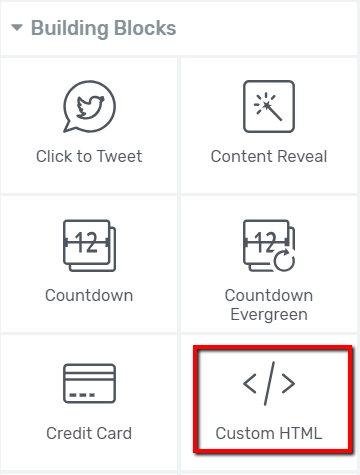
The "Custom HTML" element available in the Thrive Architect sidebar.
Louise embeds custom code within the Custom HTML element to bring some kind of special functionality to her landing pages or blog posts for the purpose of boosting targeted traffic.
For example, Louise created a custom coded Keto Calculator app for one of her KetoSummit.com pages that's generated 23,443 unique visitors in the past 30 days alone!

The Keto Calculator custom HTML app Louise embedded in a Special Content Page using the Thrive Architect "Custom HTML" element.
The custom coded calculator was copy/pasted into the Thrive Architect Custom HTML element and her traffic boosting Keto Calculator app was born.
Finally, Louise says her Breadcrumb
Category
Pages are very useful for boosting organic traffic as seen in this Keto Chicken Recipe example:
Breadcrumb Category Pages
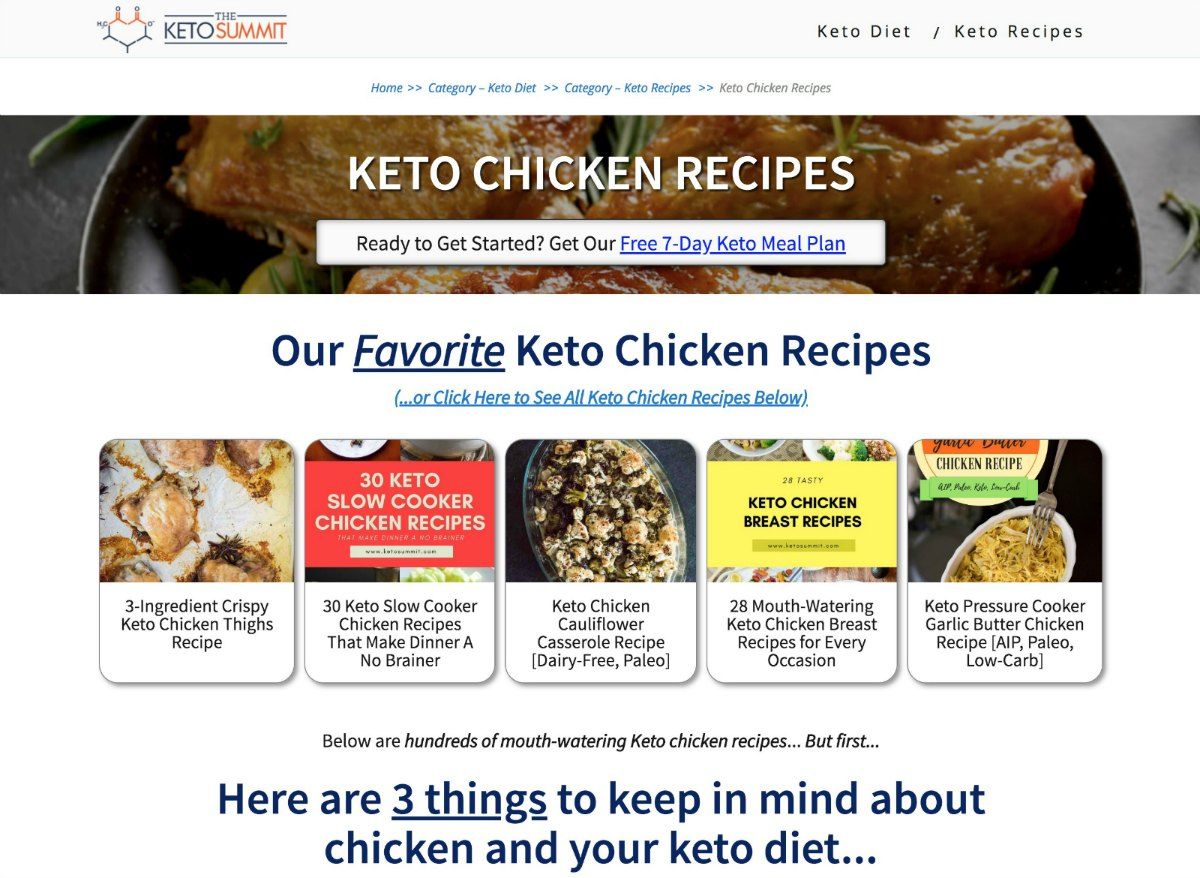
One of Louise's Category Pages with Breadcrumbs using the Thrive Architect "Post Grid" element.
All of Louise's blog posts and category pages use the Thrive Themes breadcrumbs feature.
Even though the breadcrumbs probably aren't a big ranking factor, Louise likes to use them for SEO purposes since they help to “silo” her content categories. That means each post links up to its direct category and parent category...all the way to the top-level category.
The breadcrumbs and silo structure offer easy navigation to visitors while also providing automatic internal linking back to her category pages. This is important for Louise's sites because the category pages are collections for her different recipes types people interested in Keto diets are actively searching for.
Opt-in Forms
When it comes to creating opt-in forms, Louise doesn’t have a strict process.
What’s much more important is launching her opt-in forms as quickly as possible so she can start testing them.
In fact, Louise tested 39 variations of a lightbox opt-in form for PaleoFlourish.com alone! She experimented with everything from the number of seconds before the popup displayed to the color, design and copy of the lightbox.


After 39 variations, we were pretty sure our lightbox converted well!
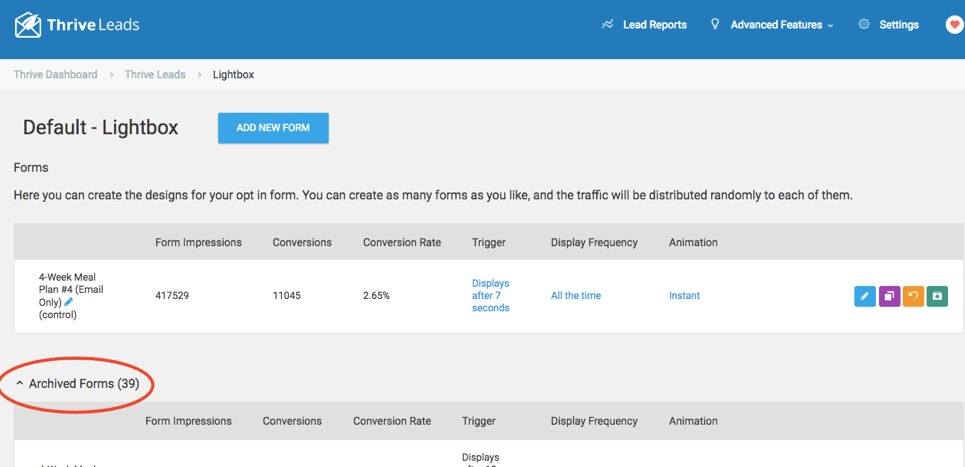
A screenshot of Louise's PaleoFlourish.com Thrive Leads dashboard highlighting her 39 lightbox opt-in form A/B tests.
And to show you Louise never stops when it comes to testing, she’s currently running a new lightbox test on KetoSummit.com as we speak:
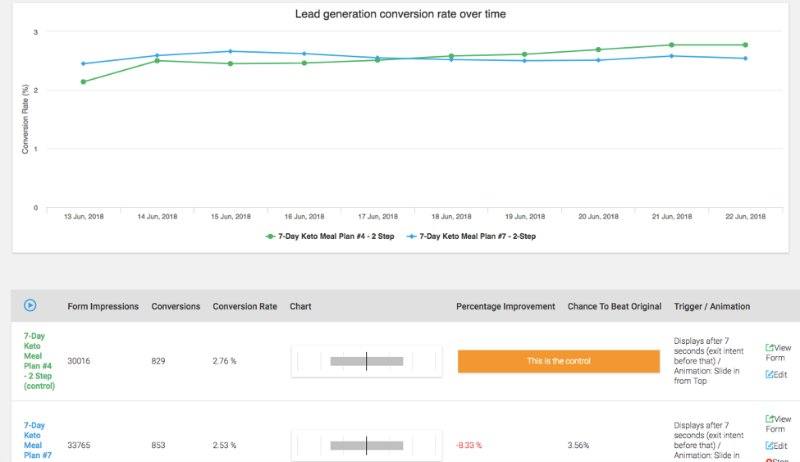
Screenshot of Louise's KetoSummit.com Thrive Leads dashboard showing her current Lightbox opt-in form A/B test.
Also, because the new Google Chrome ad blocker no longer allows lightbox opt-ins on mobile and a majority of internet users now browse the net on non-desktops, Louise says the power to control what opt-in offers appear where has become super important:

Screenshot of Louise's Thrive Leads dashboard showing how she controls the display settings of various opt-in forms for desktop and mobile.
But here's one of the most beneficial lessons Louise has acquired from extensively A/B testing her opt-in forms...she now uses them to test different offers against each other.
For example, Louise will test free beginner guides against free recipe books against free meal-plans.


The meal-plans always won!
This learning not only increased Louise's email signups, but also revealed entirely new products for her business such as a new subscription based meal-plans she just launched on a new site called Mealplan.club.
The takeaway here is that A/B testing your opt-in forms not only grows email lists, but also helps validate new product ideas if you know how to design your experiments correctly!
Landing Pages and Home Pages
Louise doesn’t spend too much time building her landing or home pages since she's finds it better to customize some of the high-converting Thrive Themes template for her own purposes.
Again, the most important thing for Louise is to get her pages shipped as quickly as possible and the 250+ Thrive Architect landing page templates help her execute fast.
For example, Louise’s KetoSummit.com Free 7-Day Keto Challenge landing page is a Thrive Architect template she quickly modified and launched:
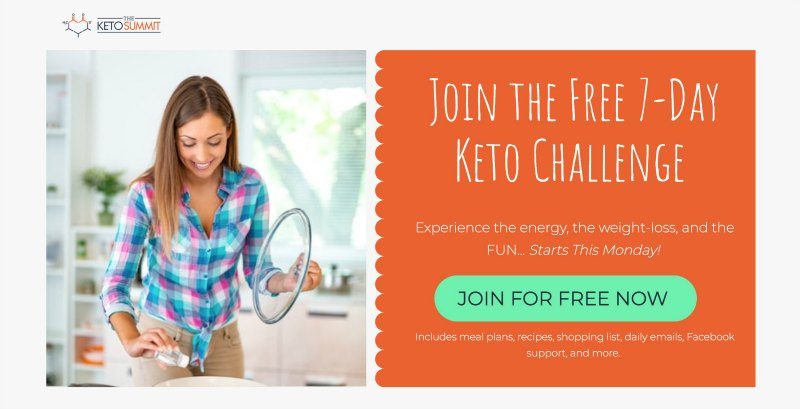
The KetoSummit.com Free 7-Day Challenge lead generation landing page example.
And for homepages in particular, once Louise customizes a template to her needs, she simply clones and repurposes it for new websites.


When you have multiple websites like us, you can create one design for your front page and then reuse it for all your other website homepages.
Take a look at how she used this homepage strategy on the following 3 websites:
Sales Pages
It may not surprise you to learn that when it comes to sales pages, Louise A/B tests the crap out of those too. How much and how often is she testing her sales pages?


We’ve been able to create and test over 50 sales pages just within the past 3 months.
Impressive! 50 sales page tests in 90 days?! How does Louise do it?
With the rapid-fire Build - Measure - Learn feedback loop Thrive Architect and Thrive Optimize provide, of course!
Louise really understands how important testing your sales page is because even a seemingly small improvement in your conversion rate translates into a HUGE difference in sales revenue.
How much of a difference can testing the design and copy of your sales page make? Here’s an example Louise shared to help illustrate this point:
This sales page originally converted at 1%:
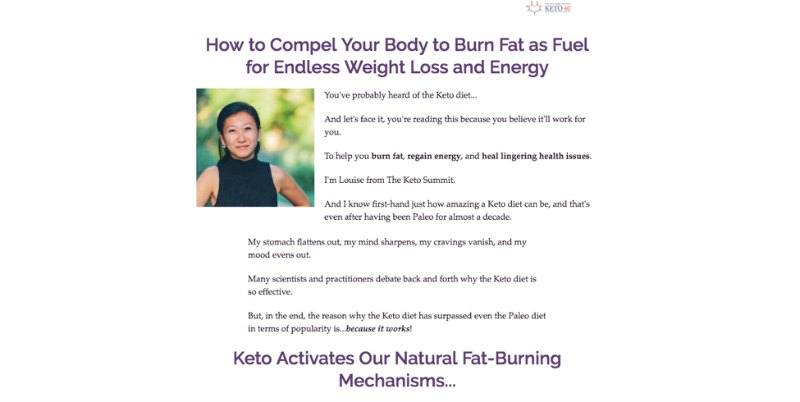
Screenshot of a KetoSummit.com sales page converting at 1% before A/B testing against other variations.
But after extensive testing of design elements and sales copy using Thrive Optimize, the current iteration of the same sales page now converts at 2%:
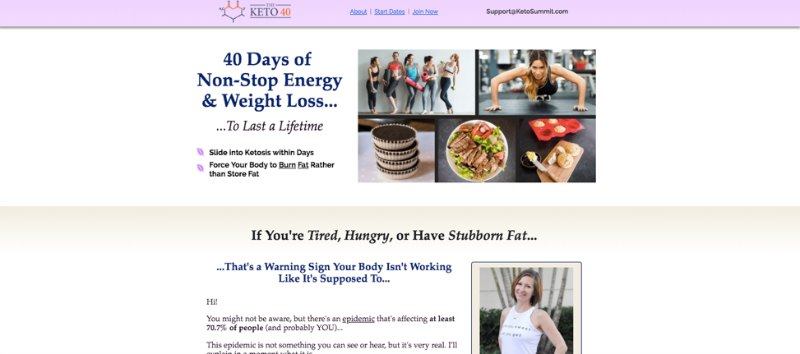
Screenshot of the same KetoSummit.com sales page converting at 2% after extensive A/B testing.
Louise says the biggest difference Thrive Themes made for her business is its ability to create sales pages super-fast. Thrive Optimize then allows her to continually run A/B tests on those pages so her conversion gains compound over time.

Illustration of what small, compounding A/B testing wins look like compared to no A/B testing whatsoever.


The first few sales pages we created took weeks of work. But now, because duplicating sales pages is so easy in Thrive Architect, we never start from scratch. That way, we also make sure it has all the correct tracking codes and mobile-friendly design.
Basically, with Thrive, we can create our own template sales pages and speed up the new sales page creation process dramatically!

Final Takeaways
So there you have it: the origin story, entrepreneurial evolution and step-by-step content generation guide for building your own info-product empire using Thrive Themes like Louise did.
Of course, your own journey to business success won’t look exactly like Louise’s so let's recap the big takeaways from Louise's story so you can apply them to your own online business:
1. Your Origin Story Is an Asset, Not a Burden
Whatever your background is, use it as an asset to build your company.
Louise showed us that her science background helped her with A/B testing and HTML coding while her corporate career taught her how to be organized and professional when dealing with customers.
Reflect on your history and you'll find all sorts of gems you can put to good use as a solopreneur.
2. Build a Business Around Your Passion, But It's Not About You...
Although Louise's online nutrition empire was built around her own interests and desire to help her father, ultimately, it didn't become a real business until she made a deliberate shift to focus on her audience's needs.
Become the cheerleader for your potential customers and they'll reward you for it.
3. A/B Test the Crap Out of Your Offers, Products and Pages
The best way to discover a high converting opt-in offer, sales page or product is to avoid wasting time trying to build the perfect one.
Take your current insights about the market, execute on your best guess about what to create, ship two versions fast, and then let the transformative power of A/B testing go to work for you.
The feedback you get from the real world will tell you what does and doesn't resonate leading to better products, higher conversion rates and happier customers over time.
4. When You Find High Converting Templates, Reuse Them
There's no need to reinvent the wheel each time you build a new website, landing page or opt-in form.
When you find a template design that works, repurpose it for your next great (or possibly bad) idea. This way, you'll avoid wasting time before the real work begins... your A/B testing.
5. Surround Yourself with More Successful Entrepreneurs
Louise says one of the best investments she’s made in becoming a successful business owner has been surrounding herself with more successful entrepreneurs than she is over the years.


They've really helped me see a different perspective to what I'm doing and why I'm doing it. It wasn’t an immediate fix, but it’s been a compounding gain over time.
6. Get Good At Selling
Selling was one of Louise’s biggest challenges early on because imposter syndrome always made her second guess whether the things she was working on were good or useful enough.
If you need help getting over your own issues with shipping projects, imposter syndrome, or procrastination due to perfectionism, make sure to listen to Shane and Hanne’s ActiveGrowth podcast series on overcoming those personal barriers here.
7. Get Out of Your Own Way
Louise's final piece of advice is to just get out of your own way:


Your customers/clients (potential or actual) have real problems in their lives, and that’s what they care about. Stop focusing on what you want (money, recognition, or even to make the world a better place) and focus on what THEY want.
Once you do that, you’ll also get most of the things you want, and you’ll be able to quickly learn what works and what doesn’t.
It’s Your Turn To Take Action
Now that you’ve read about Louise’s journey from online business newb to entrepreneurial role model, what are your next steps?
Will you crank out a new online business website in a weekend using Thrive Architect and one of our 250+ templates to validate it as fast as possible?
Or will you take a few minutes to create a quick variation of your current sales page or opt-in offer to try and improve its conversion rates?
Or perhaps you’ll set aside some time to reflect on what your customers actually need so you can give them an offer they can’t refuse… 😉
Tell us in the comments section below how Louise’s story inspired you to take a positive action for your own online business. Or if you have a similar story we would love to hear yours!





















This is an awesome story and so many actionable insights! Congrats Louise! Thanks Matt!
Cheers Samith!
wow , I will devour this article tonight after dinner
Enjoy Juan!
What a fantastic way to start my day… by reading this case study! Louise’s story resonates so much with me. It’s interesting how the same stuff always comes out: (1) deploy two versions rapidly and start testing, (2) re-use what has been proven to work (3) give your customers what they want, and not what you want. Excellent read! Thanks! Congrats, Louise!
Well said John!
Awesome and inspirational story! Her websites look amazing!
Very true Mike…we’ve got some really awesome people in the Thrive Community!
Awesome Post.
Any ideas on how she drives traffic to her sites?
She must have some good tips there as well, since to A/B Test requires plenty of “testers”…
Thanks Brent!
I didn’t really discuss traffic generation strategies with Louise for this case study, but I do know she gets a lot of traffic to her site. For example, her Keto Calculator page alone received 24,000+ visitors this past month.
I can say that Louise’s content marketing game is very strong. She does solid SEO and keyword research upfront for every article or topic she wants to write about and over time, this has earned her tons of organic traffic.
Louise also puts lots of effort into structuring her websites like SEO funnels sending that traffic towards the conversion goals she’s constantly A/B testing (see the Blogs, Articles and Special Content section above).
Brent, (Jeremy here, Louise’s husband).
For most of the 3 years, we relied primarily on SEO. Ironically, that’s something we’re not particularly great at – just OK – but we produced a lot of content, systematized the production process, and ended up driving a lot of traffic.
We still drive a lot of SEO traffic, but we’re also relying more and more on ad traffic – and to some degree, affiliate traffic.
Thanks for that additional clarity on your traffic generation process Jeremy!
any way to keep track of what has been tested?
Mine always ends up looking like a teenagers bedroom..
Even though your A/B Test reports are saved within your Thrive Themes dashboard, I also recommend tracking your test hypotheses and results in some sort of notebook or spreadsheet.
In fact, I created a free A/B Testing Results Tracker spreadsheet for exactly this purpose you can download in my A/B Testing Toolkit Thrive University course if you want to check that out.
Yeah – as many solutions as there are out there, we rely a TON on Google Sheets still for tracking everything (A/B testing, Ads, Emails, etc.).
We’ve found that we make it too complicated for a while, simplify for a while, and then repeat the process. I’m not really sure it ever ends… 🙂
Great article Matt! (BTW I’m also a geologist turned writer and music marketer) I especially like the emphasis on testing. I’m on an 8-week intensive to build out a direct to fan music funnel supported by Facebook ads and haven’t reached the heavy A/B testing phase yet. Now I see the importance. Thanks again.
Cheers Tad! Getting your A/B Testing phase started as soon as possible will bring you some conversion boosting rewards if you stay conscious about what you’re trying to learn with each test.
Best of luck with knocking out your 8-week intensive!
And nice pivot from geology to writing and the music industry…I play a little jazz clarinet myself!
Boom! Congrats Louise! Inspired me to use Thrive Optimize more. Gotta do those tests…
Just remember ABT Jonas…Always Be Testing!
Great Article. You have inspired me to give my own website a long hard look at what other improvements.
I have recently been converted to Thrive themes but have not yet looked at split testing.
A job for tonight!
That’s awesome Caelan! I hope you get your first rapid implementation split tests running right away so you can start conversion boosting your site with all the cool new insights it brings you!
Thanks, Matt, I am so pleased you put your rocks down and started writing! Great report one I will refer to often. Testimonies and case studies always inspire readers and Louise has an awesome story. Your writing ROCKS!!
Many thanks Lloyd…I’m glad to hear you found this post so useful!
And I’m happy I put the rocks down too. For me, writing educational articles for the Thrive Community is way more meaningful work than sucking oil and gas out of the ground!
Inspiring. Thank You.
Strange how things come together…
This arrived in my inbox followed by a recommendation to read this free report from Google… gni-new-consumer-insights-playbook.pdf
Sounds like the internet is trying to teach you how to give the people what they want Richard! ;-p
You guys R awesome. I watched you grow from the launch of TCB to now (4-5 yrs). I’m proud of your caring, service-oriented approach & content. Much continued success Louise, Thrive T & all Thrivers .
Thanks so much for your kind words Gerald!
This piece just made my day… Literally!
That’s awesome to hear Karl…best of luck with your own online business!
Olá, sou do Brasil, trabalho com Thrive Architect, realmente foi o diferencial nos meus negócios. Maravilhoso o post com a história de Louise, obrigado Matt Totten.
Muito obrigado Elias!
How does she add a “Popular Posts” section on her home page? I have only been able to do that on widgets, but not in the Post Grid in Architect
Thanks for your question Bryan. Since your most popular posts will rarely change, I’m sure you could accomplish this easily by using a Thrive Architect column element and insert each popular post’s feature image, header element for the title, and CTA button/link in the different columns to create a Popular Post section on your homepage.
Super post with great life-changing tips. Thank you for sharing, Matt and Louise, inspiring success story : )
Thanks Ramesh!
Matt, for a geologist, you keep cranking out some amazing journalistic pieces. Awesome case study! I loved reading it and will definitely love implementing some of the strategies you and Louise shared.
Thanks Martin! I think the trick is finding interesting stories and case studies that write themselves…Louise is such a great example of this.
Glad to hear her story gave you some strategies to implement and I’ll do my best to keep articles like this coming your way!
Fantastic article! I’m running a Genesis Theme and using Thrive Architect on one of my websites. However, after reading this I’d really like build my next site using just Thrive Architect and the full Thrive Suite. Just wondering, will I need to use a child theme for that?
Hey Peter,
Only if you need to customize your Thrive theme. If you use it as is out of the box, no child theme needed.
Hi Martin, thanks. What I’m really wanting to know is if it’s possible to use Thrive Architect alone to build a website without having to use a theme? Is that possible?
Cheers
Hi Peter,
You’ll still need a WordPress theme. You can pick a free theme and build all your pages and content with Thrive Architect but a theme will always be necessary.
Really appreciate this case study and the hustle that Lisa has in building 3 fully flesh out websites that drive traffic, leads and sales.
Thanks John!
Real curious to know how she got her hero image with optin button on each of her blog posts? I dont see an option in Thrive themes for that. Is there a special plugin
I’m not sure what exactly you’re referring to Mike…